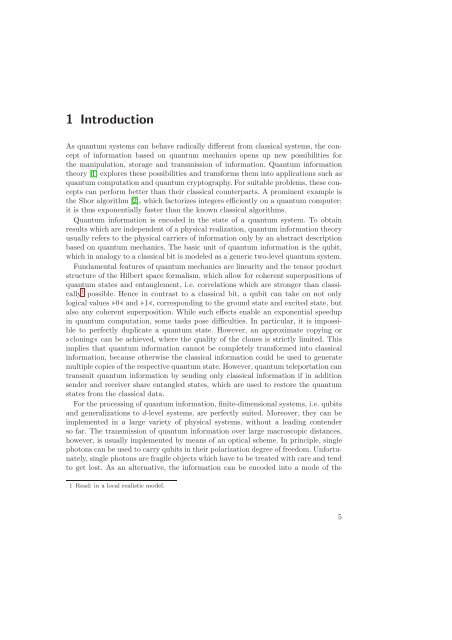Quantum Information Theory with Gaussian Systems
Quantum Information Theory with Gaussian Systems
Quantum Information Theory with Gaussian Systems
You also want an ePaper? Increase the reach of your titles
YUMPU automatically turns print PDFs into web optimized ePapers that Google loves.
1 Introduction<br />
As quantum systems can behave radically different from classical systems, the concept<br />
of information based on quantum mechanics opens up new possibilities for<br />
the manipulation, storage and transmission of information. <strong>Quantum</strong> information<br />
theory [1] explores these possibilities and transforms them into applications such as<br />
quantum computation and quantum cryptography. For suitable problems, these concepts<br />
can perform better than their classical counterparts. A prominent example is<br />
the Shor algorithm [2], which factorizes integers efficiently on a quantum computer;<br />
it is thus exponentially faster than the known classical algorithms.<br />
<strong>Quantum</strong> information is encoded in the state of a quantum system. To obtain<br />
results which are independent of a physical realization, quantum information theory<br />
usually refers to the physical carriers of information only by an abstract description<br />
based on quantum mechanics. The basic unit of quantum information is the qubit,<br />
which in analogy to a classical bit is modeled as a generic two-level quantum system.<br />
Fundamental features of quantum mechanics are linearity and the tensor product<br />
structure of the Hilbert space formalism, which allow for coherent superpositions of<br />
quantum states and entanglement, i.e. correlations which are stronger than classically<br />
1 possible. Hence in contrast to a classical bit, a qubit can take on not only<br />
logical values0and1, corresponding to the ground state and excited state, but<br />
also any coherent superposition. While such effects enable an exponential speedup<br />
in quantum computation, some tasks pose difficulties. In particular, it is impossible<br />
to perfectly duplicate a quantum state. However, an approximate copying or<br />
cloningcan be achieved, where the quality of the clones is strictly limited. This<br />
implies that quantum information cannot be completely transformed into classical<br />
information, because otherwise the classical information could be used to generate<br />
multiple copies of the respective quantum state. However, quantum teleportation can<br />
transmit quantum information by sending only classical information if in addition<br />
sender and receiver share entangled states, which are used to restore the quantum<br />
states from the classical data.<br />
For the processing of quantum information, finite-dimensional systems, i.e. qubits<br />
and generalizations to d-level systems, are perfectly suited. Moreover, they can be<br />
implemented in a large variety of physical systems, <strong>with</strong>out a leading contender<br />
so far. The transmission of quantum information over large macroscopic distances,<br />
however, is usually implemented by means of an optical scheme. In principle, single<br />
photons can be used to carry qubits in their polarization degree of freedom. Unfortunately,<br />
single photons are fragile objects which have to be treated <strong>with</strong> care and tend<br />
to get lost. As an alternative, the information can be encoded into a mode of the<br />
1 Read: in a local realistic model.<br />
5
















